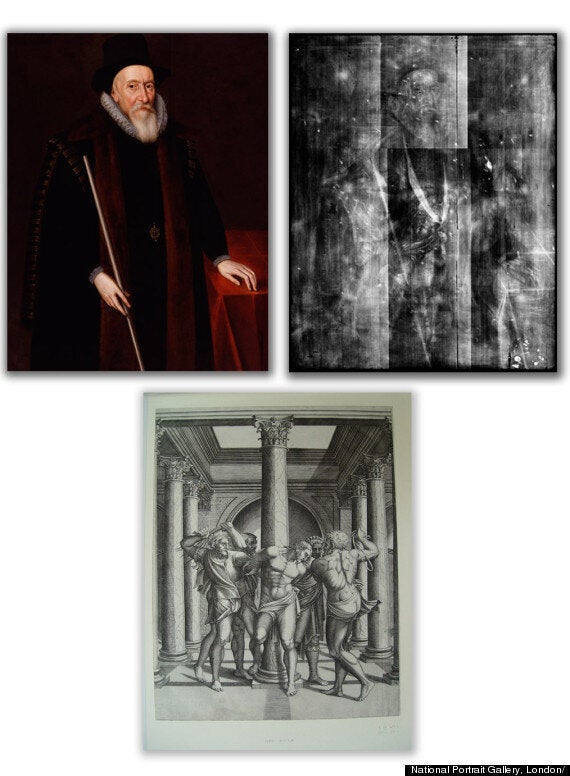Despite centuries of analysis by art historians and critics, it appears two Tudor portrait paintings have been harbouring creative secrets, until now.
Infrared reflectography and x-radiography analysis has revealed a fully worked up version of The Flagellation of Christ painted beneath the surface of a 1601 portrait of the Lord Treasurer and poet Thomas Sackville, 1st Earl of Dorset.

Thomas Sackville, 1st Earl of Dorset, Unknown artist, 1601 (top left) and the X-ray image of the portrait of Thomas Sackville, 1st Earl of Dorset (top right). The Flagellation of Christ, After Michelangelo, print by Adamo Scultori, Italian, 1547-1587 (bottom)
The painting's hidden composition, by an unknown artist, is derived from a fresco in the Borgherini Chapel in Rome by Sebastiano del Piombo after designs by Michelangelo.
Other works on display at the Hidden: Unseen Paintings Beneath Tudor Portraits display include the National Portrait Gallery’s painting of Sir Francis Walsingham, Elizabeth I’s Protestant spymaster and Secretary of State.
The portrait hangs alongside technical images that reveal the secret painting, along with The Virgin and Child in a Garden, style of Martin Schongauer (The National Gallery, London), which gives an impression of what the original composition may have looked like.

Sir Francis Walsingham, Unknown artist, late 16th century (top left) and X-ray image of the portrait of Sir Francis Walsingham (top right). The Virgin and Child in a Garden, Style of Martin Schongauer (bottom).
Dr Tarnya Cooper, Chief Curator of the National Portrait Gallery, London, said: "It has been really exciting to discover these unexpected images beneath portraits.
"The re-use of wooden panels is an example of Tudor recycling … yet, the people in the portraits painted over the top were unlikely to have known the panels were second hand."
Infrared reflectography revealed there were at least three figures beneath the Walsingham portrait and in x-ray it became evident that these were likely to be of the Virgin Mary with the infant Christ, with either the figure of Joseph or an angel also visible.
Dendrochronology (tree-ring) analysis has suggested that the panel was first used between 1547 and 1579, whilst the portrait of Sir Francis Walsingham dates to the mid 1580s.
The circumstances of the re-use of the portrait's panel are unknown, however, given Walsingham’s ardent religious beliefs he may not have approved of the re-use, had he known.
Cooper added: "In the case of Sir Francis Walsingham, the Protestant Spymaster with the Roman Catholic image of the Virgin and child beneath, you do wonder if the artist might be enjoying a private joke at the expense of the sitter."
Hidden: Unseen Paintings Beneath Tudor Portraits is running at the National Portrait Gallery, London, 3 Jan 2013 - 2 June 2013.